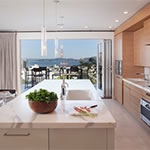
Charlot Malin is the COO and director of design at Troon Pacific.

Greg Malin is the CEO of Troon Pacific.
Starting with one home in 2000, Greg Malin and Charlot Malin have become leaders in developing sustainable homes that combine contemporary design with health and wellness. At the helm of Troon Pacific, Greg, the CEO, and Charlot, the COO and director of design, create homes that incorporate green technologies and passive design. Priced between three and thirty million dollars and regularly awarded LEED Platinum certification, Troon Pacific’s homes are the result of a goal to never compromise design, luxury, or a commitment to health and wellness.
We talk to the Malins about their philosophy and took a tour of their LEED Platinum home.
gb&d: What is a healthy home?
Greg Malin: One of the luxuries in life is health, and that is the focus in the homes we build. Healthy living today is about making a better environment for you and your family. It’s a focus on the careful integration of natural light into a home, freshly filtered air throughout, water conservation and quality, and sound attenuation—all elements associated with wellness.
gb&d: How do you approach these various elements?
Greg: By creating a solid envelope, we can control the environment by recirculating fresh, filtered air inside the home and using heat- and energy-recovery systems to take humidity and heat out of the air. This system creates a high-quality environment with stable levels of humidity and lessens the amount of energy needed to heat a home.
Charlot Malin: We also look into natural light and how we can work it into design. Our most recent home includes a penthouse surrounded by windows on all four sides with an operable skylight above. A tremendous amount of light enters through a central corridor stairwell, flowing into the entire home and providing a kind of natural air-conditioning.
Greg: And even though the water quality in the San Francisco Bay Area is exceptional, we install filtration systems that remove chloride and other things that don’t dissolve in your body. We’re also looking into new technologies using UV filtration for water filtration.
gb&d: Is LEED certification a selling point for just a specific buyer, or does it have a universal salability?
Greg: The actual certification itself? There are a few buyers who really get that and understand it, and that’s growing every day. But I would say that there is a certain level of attention to detail that comes out of the process, and our buyers appreciate that. Our development company focuses on what you don’t see, as well as what you do see.
Charlot: I think it’s sending a message, too, that we’re trying harder than a lot of the other developers out there.



At Home with Greg & Charlot
The Malins use their own home to try out ideas and develop design practices to incorporate into future projects. Here are a few of their favorite things.
Serene Environment
With foldable doors and extensive natural light, the home blurs the line between indoor and outdoor living.
Reused Materials
The home used existing framing material and wood from managed forests.
Renewable Energy
Solar panels produce a third of the home’s energy but are almost completely invisible.
gb&d: How many homes do you build ? And how many homes do you want to build?
Greg: At any given time, we typically have three homes at some stage of construction, and our goal is to have six to eight.
Charlot: And potentially some multifamily housing, as well. We’re currently in the process of working on the development and investment fund for multifamily projects.
gb&d: You concentrate on building in urban environments. Was that a conscious decision?
Greg: Yes, and this is where some of the hardest work needs to be done, where you have the most influences from the surrounding environment. When you enter a Troon Pacific home, you enter a very serene environment, an escape from the hustle and bustle of the city into a spa-like experience.
gb&d: Do you think that people in the San Francisco area are more receptive to this kind of thing?
Greg: I think our society, in general, is becoming much more conscious of the effects of cities on the environment around us. I think that New York, Chicago, and Los Angeles are cities that are becoming more green, but I do think that San Francisco is a leader. It’s where the USGBC was founded, and we are getting the word out there that we need to be more sensitive to the environment and be more careful with our resources. Even though we build beautiful, high-end, luxury homes, it doesn’t mean that it isn’t at a level of consciousness that makes it sustainable.
gb&d: What are some significant developments since your first house in 2000?
Charlot: I have to say that the industry has become more sophisticated when it comes to design and green building tools. Windows, for example, used to be really thick and clunky. The solutions have become more elegant and smoother. Finish material, such as sustainably managed exotic woods and low-VOC paints, have become better in terms of not compromising quality or design. The choices are [better] than they used to be.
Greg: We ask ourselves, “Can we make a luxury passive home that doesn’t compromise our level of aesthetics?” It’s challenging because there is a lot that goes into doors and windows and detailing that’s on a level that not everyone does. We don’t have as much choice in terms of manufacturers of different components, so we have to work with them, and sometimes that influences design.

